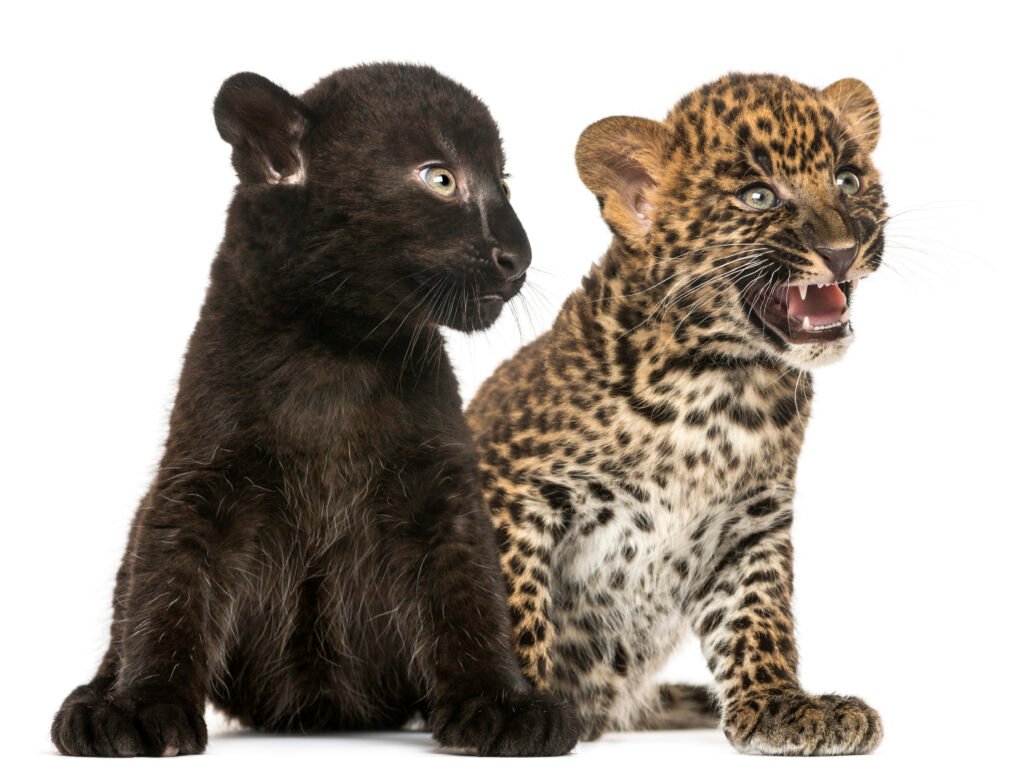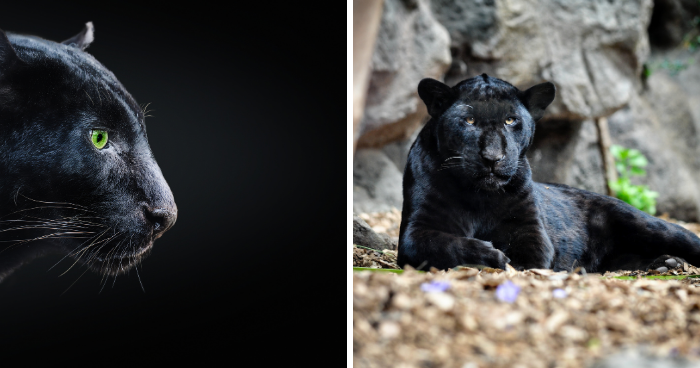Black leopards, sleek, dark coats, and secretive nature have captivated humans for generations. These creatures, often called “nature’s shadowy predator,” are strange and unusual, blending in with their surroundings like forest ghosts. But what makes black leopards so appealing? Is it their unique melanistic coats, stealthy hunting skills, or the air of myth and mythology surrounding them? Let’s delve deep into the mysterious realm of black leopards to discover their mysteries.
Table of Contents
What Are Black Leopards?

Black leopards are the same species as the common leopard (Panthera pardus), but melanism, a hereditary disease, causes their unusual black coats. This disorder results in an overproduction of the pigment melanin, giving it a gloomy appearance. While their markings are still present, the black color obscures them and makes them only partially visible in certain lighting conditions.
Though frequently confused with black panthers, it is crucial to highlight that “black panther” refers to any large cat with melanism, including jaguars and leopards. In truth, black leopards are just leopards with dark coats.
Distribution and Habitat

Black leopards are distributed throughout Africa and Asia, especially in the deep jungles of India, Sri Lanka, and Southeast Asia. Their affinity for dense jungle surroundings gives them plenty of cover, allowing them to hunt stealthily in the darkness. They are less common in Africa but have been seen in Kenya and Ethiopia.
Their habitat is directly related to their requirement for concealment. Their melanistic coats let them blend into dense, gloomy surroundings where sunlight rarely shines through. As a result, these strange species thrive in Asia’s jungles.
Melanism: Nature’s Genetic Quirk

Melanism is a genetic mutation that causes abundant black or dark pigmentation. In the case of black leopards, this mutation is sometimes regarded as an evolutionary adaptation, allowing the cats to hide better in the dimly lit woodlands where they prey. Unlike albinism, which causes a lack of pigmentation, melanism produces an excess.
Interestingly, while melanism offers black leopards an advantage in their jungle surroundings, it is a recessive trait, which means it is handed down genetically but not in every litter of kittens. A leopard can inherit the melanism gene without expressing it, resulting in a mixture of regular and melanistic progeny.
How Black Leopards Hunt

A black leopard’s hunting arsenal relies heavily on stealth and surprise. These predators are masters at the ambush, using their dark coats to remain practically undetected as they approach their victims. Black leopards use patience and quickness to chase deer, wild boar, and small mammals. Their ability to attack quickly before the prey can escape makes them formidable predators.
Interestingly, their black coats may provide a benefit in certain situations, particularly at night. While typical leopards are superb hunters, the black leopard’s pigmentation provides additional camouflage in the jungle’s shadows.
Nocturnal Predators: A Black Leopard’s Advantage

Black leopards are nocturnal predators that hunt primarily at night when their dark pigmentation offers them an advantage. Their black fur lets them blend into the darkness, making them nearly invisible to prey and possible enemies. While ordinary leopards are more noticeable in moonlight or against the night sky, black leopards are well-suited to their murky world.
This inherent advantage extends to their ability to track prey undetected because darkness masks their every motion. This is why black leopards are commonly considered nature’s greatest shadow predators.
Diet and Prey

Black leopards, like their lighter-colored siblings, are opportunistic feeders. Their diet usually comprises a variety of foods, ranging from tiny mammals like mice to larger species like deer and wild boar. In some areas, they may even hunt livestock, which can lead to confrontations with humans.
Black leopards’ versatility is essential to their existence. They may change their diet based on the availability of prey in their region, allowing them to live in various settings, including dense jungles and savannas.
The Role of Black Leopards in Local Ecosystems

As apex predators, black leopards are essential in ensuring environmental equilibrium. Hunting herbivores like deer and wild boar helps to limit their populations, prevent overgrazing, and maintain ecological health.
In areas where black leopards thrive, their presence helps to keep fewer animals under control, reducing competition for food supplies. This top-down management is critical to the health of their environments.
Myths and Legends Surrounding Black Leopards

Black leopards have long been associated with folklore in many cultures. Their elusive character, paired with their spectacular beauty, has spawned stories and legends. In some cultures, black leopards are emblems of power and mystery; in others, they are seen as omens or jungle protectors.
In ancient mythology, these creatures were frequently connected with gods or spirits, and their ability to vanish into the night fueled rumors of their extraordinary skills.
Black Leopards in Popular Media

Black leopards have also impacted modern society, appearing in books, films, and artwork. Their sleek, secretive look has made them famous characters in fantasy and adventure novels, where they are frequently portrayed as noble and powerful creatures.
Black leopards continue to enchant audiences with their beauty and intrigue, whether as comic book characters like the Black Panther or in wildlife documentaries.
Conservation Status

Black leopards’ conservation status is difficult to establish due to their scarcity and elusive nature. The International Union for Conservation of Nature currently classifies leopards as “vulnerable,” which means they suffer serious challenges such as habitat degradation, poaching, and human-wildlife conflict.
Conservation projects are being developed to conserve leopards in general and black leopards in particular, protect their habitats, and reduce human-leopard conflict.
Threats to Black Leopards

The main risks to black leopards are the same as for other big animals. One of the main threats is habitat loss, which frequently results from deforestation and agricultural expansion. As their native habitats dwindle, black leopards are forced to come closer to humans, which can lead to lethal conflicts.
Another serious threat is poaching, which kills black leopards for their pelts and body parts. Climate change also provides long-term concerns since it alters the ecosystems on which black leopards rely for existence.
Black Leopards vs. Other Big Cats

Black leopards are more elusive and solitary than other large cats, such as lions and tigers. They rely primarily on stealth rather than strength, unlike lions who hunt in pride or tigers known for their tremendous force. Their melanistic appearance distinguishes them from other leopards, adding to their mystery and attraction.
Famous Black Leopard Sightings

Black leopard sightings are extremely rare, adding to their mystery. In 2019, a black leopard was famously photographed in Kenya, the first confirmed sighting in nearly 100 years. This occurrence revived the world’s intrigue with these enigmatic predators while emphasizing the difficulty of studying such an elusive creature.
Conclusion
Black leopards are creatures of mystery and beauty, with melanistic coats distinguishing them from the rest of the animal kingdom. With their stealthy nature, nocturnal habits, and role as apex predators, they exemplify the essence of wilderness. As we learn more about these intriguing animals, it becomes evident that safeguarding them is critical for their existence and the ecosystems they support.
FAQs
Are black leopards and black panthers the same?
“Black panther” refers to any big cat with melanism, such as black leopards and jaguars.
How often do black leopards appear in the wild?
Melanism affects approximately 11% of leopards in particular groups, making black leopards rare.
What distinguishes black leopards from other leopards?
The fundamental distinction is their black pigmentation due to melanism, even though they are genetically identical animals.
Are black leopards more dangerous than other leopards?
Black leopards are not intrinsically more dangerous, but their melanistic coats may provide an advantage in some hunting conditions.
Where are black leopards most often found?
They are typically found in Asia’s deep woods, specifically in India, Sri Lanka, and Southeast Asia.

